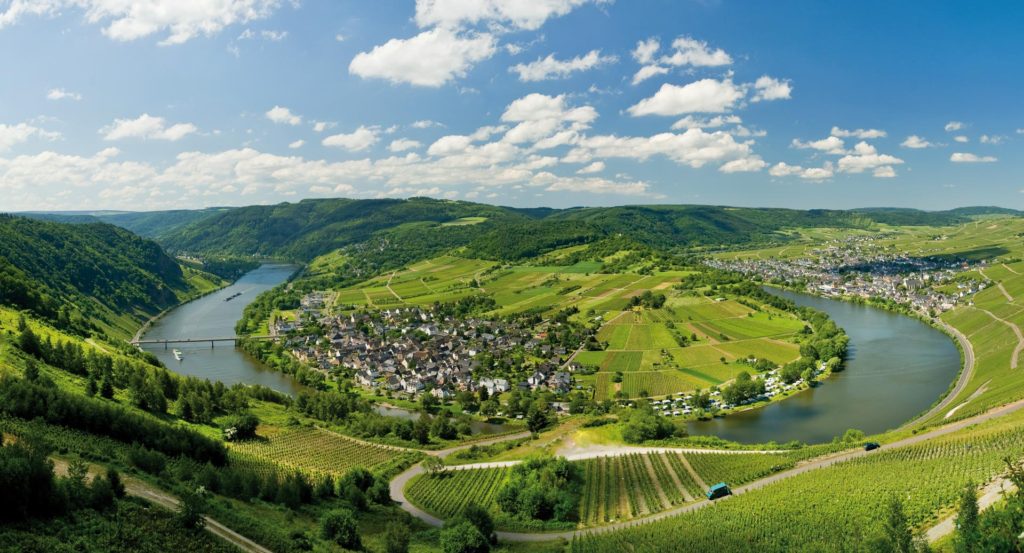Roughly around the time King Charles II returned from exile to become the king of Great Britain and Ireland; Aurangzeb, India’s most controversial Mughal emperor confiscated the throne from his father the great Mughal Emperor Shah Jahan (who built the UNESCO heritage site – Taj Mahal in the memory of his beloved wife Mumtaj Mahal); the navigation act was passed by the British Parliament to control commerce in the new world; the Selbach Oster family were busy establishing themselves as a world-class winery, in their little parcel of heaven we call Mittel Mosel (middle mosel). Where the renowned villages of Bernkastel, Piesport, Braunberg, Wehlen, Urzig, Erden are hallowed ground for Germany’s crowning jewel – Riesling.
Fast foward to 2018 – that’s 400 years of dynamic history, making wine in one place, dedicated to one grape – Riesling. It’s 400 vintages – the good, bad, and the ugly, that screams inimitable expertise, with one constant – the Selbach’s successfully continue their reign as one of the top estates of Germany.
As Pinot Noir is to Burgundy, Nebbiolo to Piedmont, Syrah to Hermitage, Germany is the holy grail for all things Riesling – one of the most versatile white grape variety in the world, capable of evolving into some of the longest-living, racy wines. Riesling from Germany (Mosel) can be as delicate and light on it’s feet as a ballerina or be demanding, precise, intricate like Tango, dipped in honey, tropical fruit, and mineral.
If you relish juicy ripe peaches and apricots, sweet fragrance of jasmine flowers, zesty lemon and lime, luscious honey, spicy ginger, or if you are like me, turning cartwheels in your mouth at the mere mention of acid, you are going to love Riesling.
Riesling’s sine non qua, most valuable asset (in our humble opinion) is it’s fruity tartaric acid and ability to retain mouth-watering acid. This dynamic synergy of high acid, integrated with healthy, perfectly ripe fruit, delivers world class wines that are both graceful and powerful. Wallet-friendly wines that holds its ground to just about any cuisine and course, from gastronomical quickies to decadent deserts. Be it savory, sweet, or extra spicy (just the way we like it).
Harvesting grapes or training for winter Olympics?
It’s extreme sports, but for a living. While top alpinists these days are working pitches in the low to mid-60s, the precipitous terraces of Germany, swagger 65% plus inclines. In fact 85% of the Selbach Oster vines are on such insanely steep slopes, where mechanical harvesting is impossible and nearly 7 times more man-hours are required in Mosel than in flatter terrain such as the Médoc.
Great wines that exhibit balance, finesse, and a sense of place begin in the vineyard. They come from exceptional grapes grown in extraordinary terroir, and cared for by gifted winemakers. Hand harvesting is mandatory at Selbach Oster, and typically involves several pickings, to hand select only the best quality fruit. Which means that in poor vintages, Selbach-Oster will choose to abstain from producing any wine or declassify to a lower Prädikat level, rather than succumb to juice that doesn’t meet their highest standards. That my dear friends is the quality hallmark of integrity and commitment.
Unlike Chardonnay, a non-aromatic grape that relies on complexity and depth through various wine making regimes – malolactic fermentation, battonage, oak maturation. German wine maker’s strive to capture the transparency and pure expression of Riesling – vinification is carried out in a combination of fuder and stainless steel, slow and cool fermentation, wild yeasts, minimal intervention, including no fining or oak maturation. The result: intense, fruit-driven, expressive wines that dance in your glass like a seductive siren.
Viticulture is only possible at such northerly latitude (51 degrees, where the annual average temperature is 49° F, —8° colder than the grapevine’s ideal annual temperature), in part due to the vineyards carved at stone’s throw proximity to the meandering river – Mosel/Rhine, that reflects warm sunlight on to the vines and partly thanks to the well draining blue Devonian slate, where Riesling reigns supreme. The dark stones retain heat, radiating warmth at night. Long daylight days allows grapes to ripen fully, reaching all levels of pradikat sweetness.
Shaped by this unique terroir, Selbach Oster Rieslings are brimming with seductive ripe fruit and counter balanced with lively acid, an ideal yin and yang of fruit & acid.
I discovered the magic and convenience of GPS mapping aka Everyvine while attempting my very first harvest at Brooks Winery in Oregon last year. Without these online mapping tools, to precisely locate individual parcels and vine rows, I would have surely brought home our neighbor’s fruit, even worse an entirely different varietal.
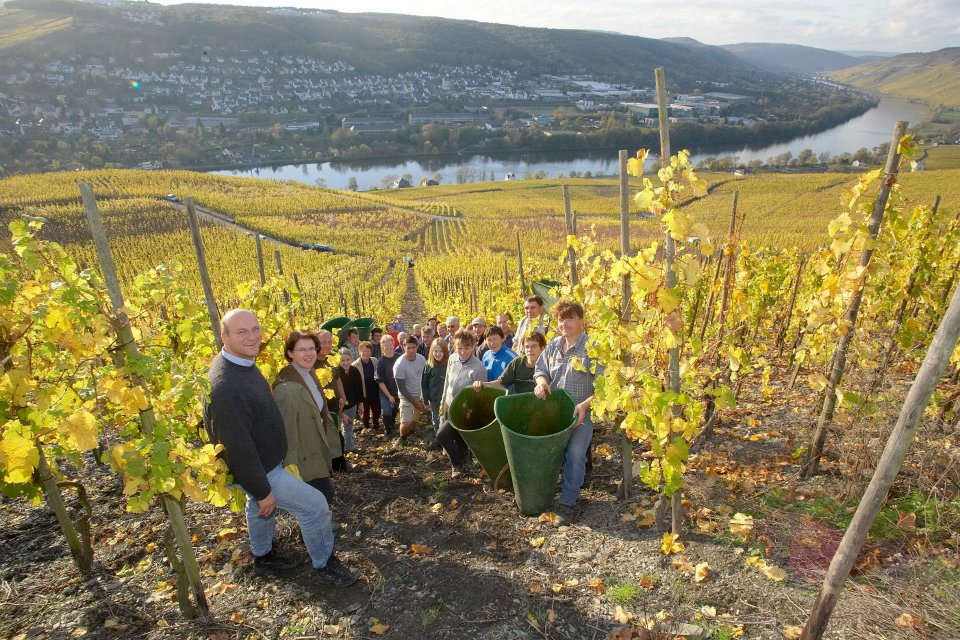
Speaking of harvest, like Burgundy, where Napoloenic law of inheritance divided vineyards into tiny parcels, Germany too was struck with similar woes. Unlike the new world wine producing regions, the only way to identify single vineyard boundaries and vines is via color coded flags or old school signage. Good Samaritans as they are, the Selbach family like many of their neighbors, doesn’t pick all their fruit in order to compensate for the accidental picking conducted by their temporary harvest crew.
Shall we taste?
Germany’s highest quality bottlings are called Prädikatswein, The grapes must originate in one of Germany’s 13 official wine regions (anbaugabiete) and within single Bereich (district). Chapatalization is not allowed and wines are further classified on the amount of sugar in must (not finished wine), measured in degrees according to the Öchsle scale (ERKS-LEH). Six grades: Kabinett, Spätlese, Auslese, Beerenauslese, Trockenbeerenauslese, and Eiswein.
Kabinett (70–82 °Oe): Signifies the grapes were picked at normal harvest time, the grapes are greenish-yellow in color, with crunchy texture, that produce the most delicate of all German wines. Typically Mosel Rieslings swagger feather light body, low octane, and see no heavy oak to stand in the way of a happy match. These are wines with mouth watering acidity, herbal and minerally nuances that makes them especially fantastic seafood partners, 365 days/yr in our sunshine state, with Key West Florida Shrimp or the seasonal stone crab.
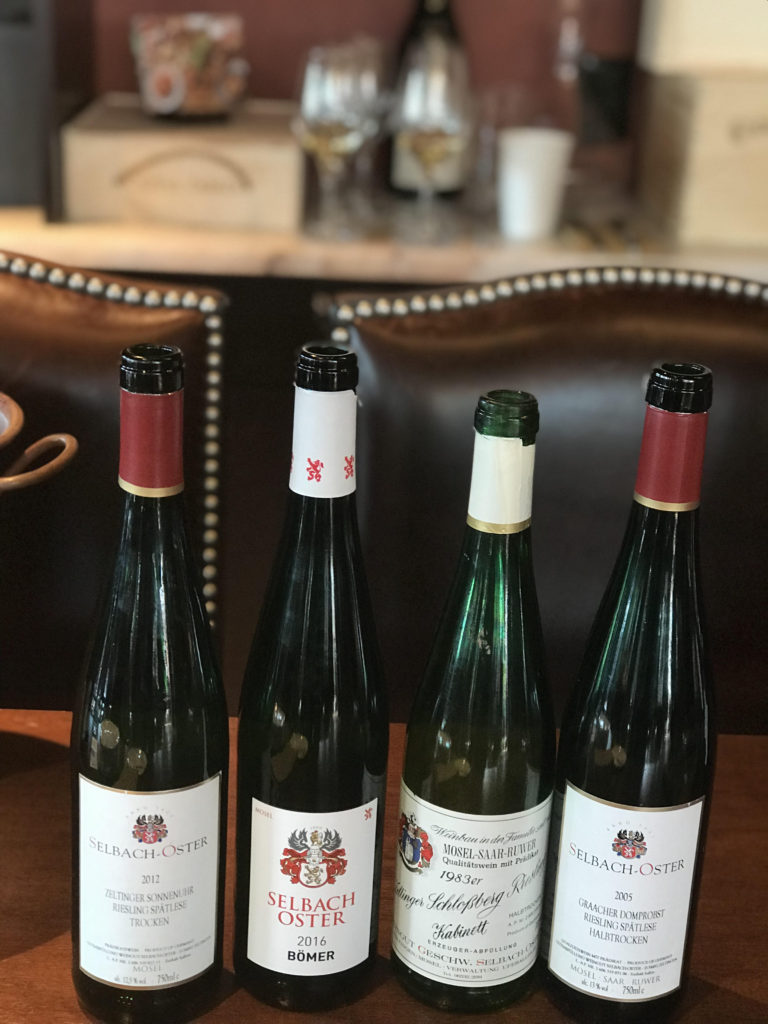
Flight 1:
2012 Selbach-Oster Zeltinger Sonnenuhr Riesling Spatlese Trocken: From the grand cru vineyards of “Zeltinger Sonnenuhr”, comes this alluring beauty that is weirdly rich, but one that matches the bone dry (trocken) finish. Fresh peaches and pear kissed with subtle aniseed, sweet lemon, and a lingering finish. This impeccable balancing act of zippy acid and ripe fruit, is probably Johnannes secret arsenal. It’s like an elephant stealthily walking on a tightrope. Amazing!!
2016 Selbach-Oster Zeltlinger Schlossberg “Bomer” Riesling: “Bomer” is a single vineyard aka lieu diet, situated in the lower portion of the hills, where Riesling planted on deeper soils, expresses a rounder, approachable wine even in it’s youth.
Flight 2:
1983 Selbach-Oster Zeltinger Schlossberg Riesling Kabinett Halbrtocken: 35 years old, and singing! A cerebral expression like a well-aged sherry, roasted walnuts, mint, sage, finishing with a touch of sweetness (halbtrocken) and zippy acid.
2005 Selbach-Oster Graacher Domprobst Riesling Spatlese Halbrtocken: Edelfirne at its best. An outstanding vintage produced super ripe grapes, with the kind of concentration you normally associate with BAs and TBAs. Slow (10 months) and cool fermentation resulted in a rich palate of salted caramel, nuttiness, all bound elegantly with honeyed fruit and well integrated acidity.
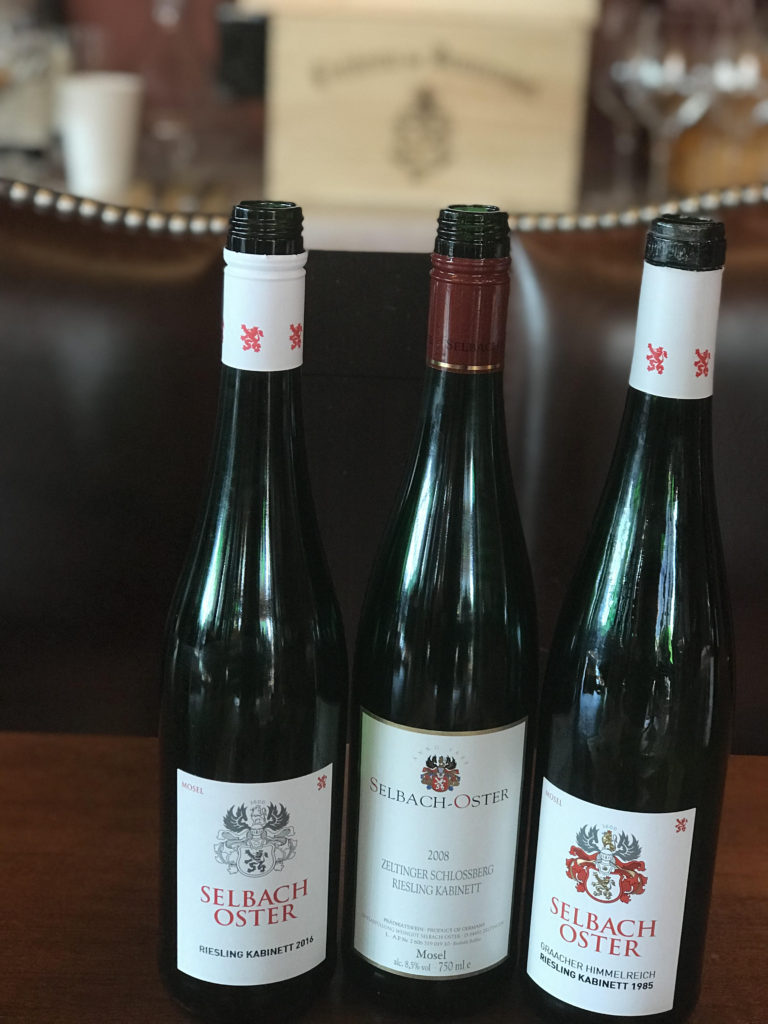
Flight 3:
2016 Selbach-Oster Mosel Riesling Kabinett: Conveniently accessible at first and business class airline lounges and cruises, Mosel Kabinett Riesling is the signature estate wine of Selbach-Oster and a quintessential example of Mosel Rieslings – pure, mouth-watering, delicate yet intense notes of green apple, lime zest, wet stones, finishing with zippy acid.
2008 Selbach-Oster Zeltinger Schlossberg Riesling Kabinett: Who needs caffeine? This is my wake up call. Capturing the soul of Mosel, even after a decade, the vibrant acid shines through – roasted walnuts, butterscotch, stone fruit core, and the elusive umami in the mid-palate, the 2008 Schlossberg is Kabinett Riesling at it’s best.
1985 Selbach-Oster Graacher Himmelreich Riesling Kabinett: Aptly chosen from single-vineyard site, Himmelrieich (the kingdom of heaven) comes this rare treat chosen to commemorate the serendipitous meeting of Selbach Oster with the Milotes family. Complex, intriguing, wildly herbal, lip smacking salinity, lively acid, all hallmarks of a great vintage.
Spätlese (76–90 °Oe): Literally ‘late harvest’, Selbach Oster looks for succulent grapes and golden freckled skin. These late-harvested grapes exhibit higher ripeness, and the end result: fuller, more concentrated, sweet fruit flavors than Kabinett.
Spätlese is our favorite style of German Riesling, it’s the precise trinity of lush tropical fruit, vibrant acidity, and the touch of sweetness that makes it probably the most accommodating and serious bargain for food pairings.
Think dishes with fruits – duck with figs, roast pork with apples, turkey with pear stuffing, that pair beautifully with fruit-driven Rieslings.
We were so mesmerized with the ravishing fruit of Selbach-Oster’s Riesling, that we neglected to notice the non existent “diesel-fuel” aroma.
Sip on this: the quintessential aroma, we associate with Riesling – diesel/petrol, technically “pine sap” or TDN, (compound 1,1,6-trimethyl-1,2-dihydronaphthalen), is considered a flaw in young Rieslings. It is a sign of sunburned grapes caused by excess onset of rapid heat. In aged Rieslings on the other hand, it’s a natural progression and evolution, which adds complex nuances to an already pleasurable wine.
While flight 4 consisted of siblings parading different ages, flight 5 symbolized a contrast of vintages.
Flight 4:
Did we mention the trifecta of deliciousness: acidity, sweetness, and richness, combined together – it might just be the gateway to your love affair with Rieslings and Germany in particular.
The 2001 Selbach-Oster Bernkastler Badstube Riesling Spatlese, still youthful and light on it’s feet, concentrated apple, peach, and ripe melon flavors. While the younger 2009 Selbach-Oster Bernkasteler Badstube Riesling Spatlese was brimming with spice, fresh citrus, and invigorating acidity.

Riesling’s thin skin is a bag of mixed blessings. Depending on mother nature and humidity, Riesling can blossom or be consumed by its arch nemesis – bunch rot (fungal disease), leaving the grapes unpalatable and unworthy of crafting good juice.
Flight 5:
From the steepest single vineyard in the village of Zeltinger, the 1990 Selbach-Oster Zeltinger Sonnenuhr Riesling Spatlese, dances gracefully with enthralling aromas of hazelnuts, sweet mint, nuanced dried herbs, with a deliciously peppery finish.
On the other hand, the contrasting 1976, a perfect vintage of healthy fruit kissed with noble rot (edelfäule aka botrytis cinerea), even at Spatlese quality level, was dazzling with exotic spices, honey, ginger, amazing balance and richness. 1976 Selbach-Oster Wehlener Hofberg Riesling Spatlese – That’s 40+ years in the bottle, these wines are practically indestructible and a delightful legacy to celebrated with.
Auslese (83–100 °Oe): Translates to ‘harvested from’ bunches of extra-ripe grapes that may not be affected by precious Edelfäule. Typically, Auslese is selected by successive passes, picking fruit for Kabinett and Spätlese first, and leaving the healthiest berries on the vine to concentrate. Resulting wines are intense in both aroma and flavor, traditionally sweet, but remember even the sweet wines thanks to Mosel’s bracing acidity do not taste overtly sweet.
Hankering for sweet-spicy Thai or Sichuan spiked Chinese – sweetness of Auslese to the rescue. Alcohol releases heat which makes hot food taste hotter. Counterbalance with low octane wines such as Mosel Rieslings (7% abv vs Napa Chardonnay ringing in at 13-14% abv). The sweetness of Auslese combined with mouth watering acidity, cools the palate and keeps the flavors fresh and lively.
Beerenauslese (and Eiswein 110–128 °Oe): ‘selected berries’ that boast exotic spices, ginger, and saffrom aromas of noble rot. These wines are rich, luscious, made only in the very best vintages, sold in half bottles. Imagine climbing a 65-85% steep gradient hill, with one hand on a pulley wire and the other to hand-pick individual berries, not grape bunches – that’s heroic harvesting in our books.
Pairing: With winter at our doorsteps, think apple pie, creme brulee, blue cheese platter, and pear crostatas. Sipping a glass of beerenauslese or trockenbeerenauslese Riesling, surrounded by good friends, after an incredible meal, we can summarise our experience into one word, oh well make it 2 – pure joy!
Flight 6:
2016 Selbach-Oster Zeltinger Himmelreich Riesling Auslese: sweet pineapple and melon, luscious with refreshing acidity, and a lingering lip-smacking finish.
2006 Selbach-Oster Zeltinger Schlossberg Riesling Beerenauslese: Another dynamic and precise combination of richness and raciness, candied apricots, dried raisins, roasted almond, sweet caramel, honeyed ginger, and a finish that goes on for minutes.
2006 was the monumental vintage of Johannes Selbach’s career for dessert wines. These are wines that are meant to be shared at epic moments such as graduation, heck they even promise to stay strong and lively to celebrate your grand children’s birth.
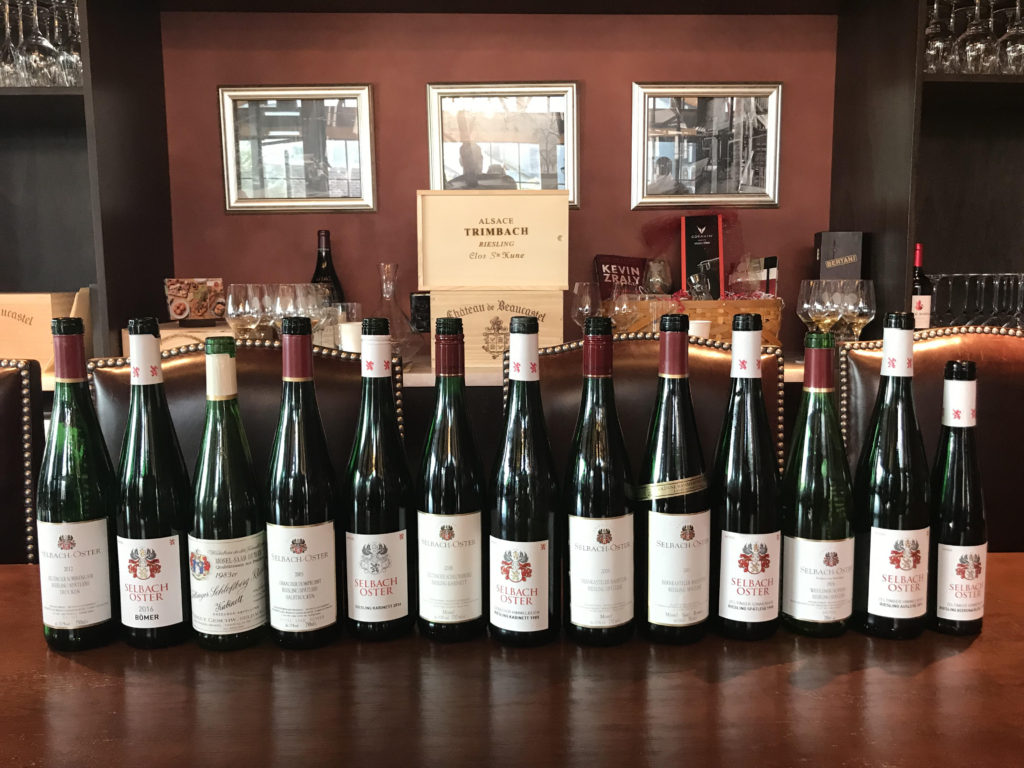
Trockenbeerenauslese (150–154 °Oe): “dried berries late picked’. Produced only in the greatest vintages, these golden elixirs are made from hand picked, individual grapes that have shriveled to raisins by edelfäule, resulting in wines that are very sweet, extremely concentrated, and luscious. Only available in half bottle sizes due to it’s rarity, commanding high prices (at par with Sauternes), due to the labor-intensive production costs (it takes 1 person an entire day to select berries to produce 1 bottle) and the extreme wine-making difficulties in trying to produce outstanding wines with such viscous juice (at such richness, fermentation is extremely challenging, alcohol levels as low as 5.5% abv).
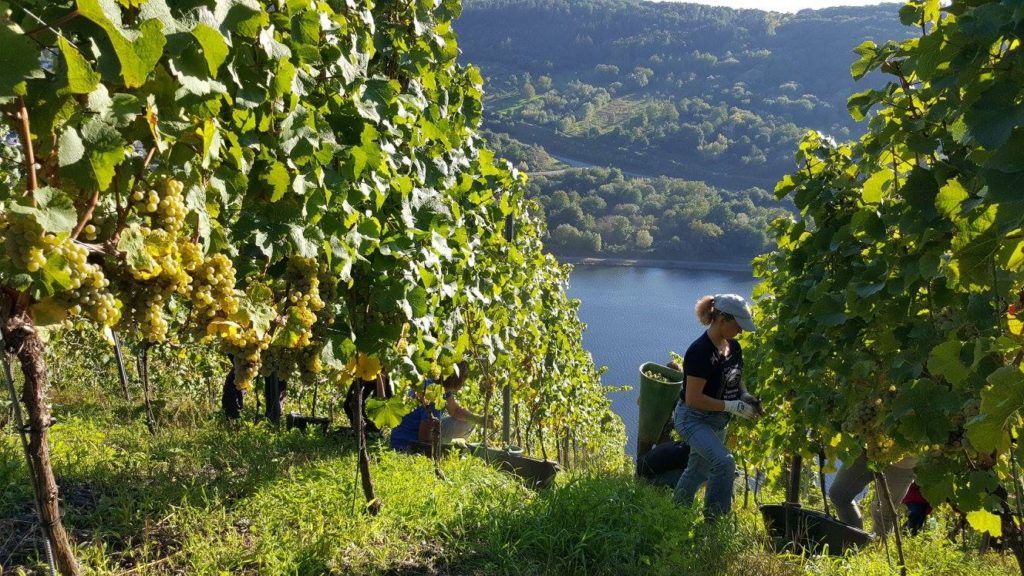
To be honest, I am not a fan of dessert pairings. It’s a sensory over load of sugar, and neither do I care to sip juice that is texturally similar to honey. Hence, wine in itself is dessert for me. And if I had hankering for something sweet, I invariably will reach for a sweet Mosel Riesling – Eiswein or BA. Why? It’s Riesling’s naturally high acidity which balances the unctuous juice, leaving my palate fresh and lively with each sip. The definition of a well-made dessert wine, in our opinion, however sweet, should always show as a whole and not be dominated by either structure – richness or acid.
The brilliant collection of Selbach Oster Rieslings are the epitome of clarity, balance, and breathtaking precision. Perhaps the driest, yet richer of their equally talented neighbors, Selbach Oster Rieslings are honest wines, shimmering with ravishing fruit, laced with energetic acidity, lingering herbal-mineral nuances, food-friendly, versatile, wines that offers maximum flexibility from trocken (bone dry) to lusciously decadent. Throw in just about any cuisine in the world, its versatility is boundless.
It’s not just delicious grape juice, it’s 400 years of history battling the tides of climate and fashion, 400 years of struggle, perseverance, and hope that you taste in each glass of Selbach-Oster Rieslings.
If you had only white wine to choose from, make it count – drink RIESLING!
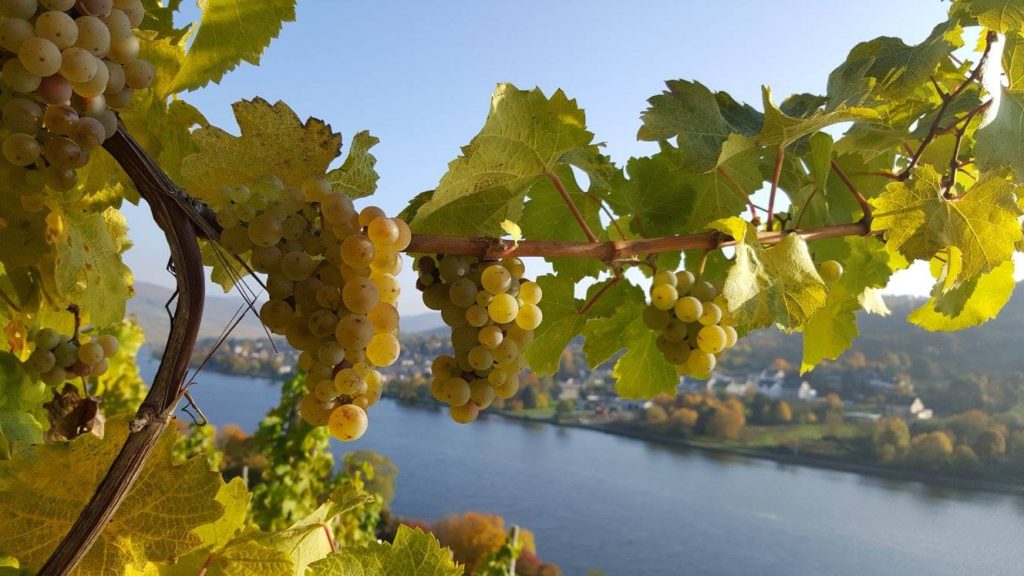
Thousand thanks to MS George Milotes and his phenomenal new wine bar Wine George Bar for hosting a sensational soiree!
